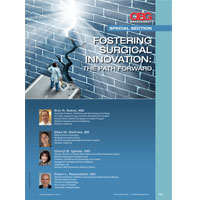User login
Article Type
Changed
Tue, 05/21/2019 - 12:15
Display Headline
Fostering surgical innovation: The path forward
How do we get past the current “chill” on innovation in gynecologic surgery? By talking to innovators themselves, we can discuss and dissect the process, and focus on moving forward.

Click here to download the PDF.
Key learning objectives
The faculty for this roundtable aim to:
- Explain the process for bringing an innovation to market, including the roles of surgeon inventor, engineer, manufacturer, and industry
- Discuss best practices, based on lessons learned, when pursuing an innovative idea for patient care
- Articulate ways to improve upon the entire development process for new techniques, devices, etc, being brought to the FDA for possible approval and to market for patient use.
Publications
Topics
Sections
How do we get past the current “chill” on innovation in gynecologic surgery? By talking to innovators themselves, we can discuss and dissect the process, and focus on moving forward.
How do we get past the current “chill” on innovation in gynecologic surgery? By talking to innovators themselves, we can discuss and dissect the process, and focus on moving forward.

Click here to download the PDF.
Key learning objectives
The faculty for this roundtable aim to:
- Explain the process for bringing an innovation to market, including the roles of surgeon inventor, engineer, manufacturer, and industry
- Discuss best practices, based on lessons learned, when pursuing an innovative idea for patient care
- Articulate ways to improve upon the entire development process for new techniques, devices, etc, being brought to the FDA for possible approval and to market for patient use.

Click here to download the PDF.
Key learning objectives
The faculty for this roundtable aim to:
- Explain the process for bringing an innovation to market, including the roles of surgeon inventor, engineer, manufacturer, and industry
- Discuss best practices, based on lessons learned, when pursuing an innovative idea for patient care
- Articulate ways to improve upon the entire development process for new techniques, devices, etc, being brought to the FDA for possible approval and to market for patient use.
Publications
Publications
Topics
Article Type
Display Headline
Fostering surgical innovation: The path forward
Display Headline
Fostering surgical innovation: The path forward
Sections
Disallow All Ads
Alternative CME
Consolidated Pubs: Do Not Show Source Publication Logo
Use ProPublica